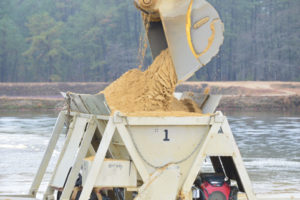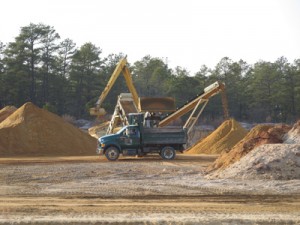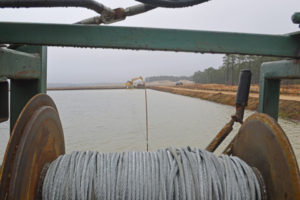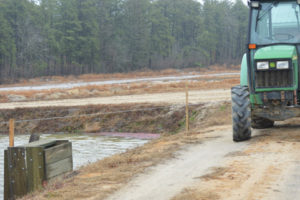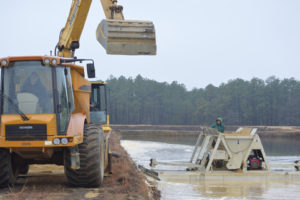Winter tasks are well underway! The winter flooding has begun, which means that it’s once again time to start sanding.
Sanding is a fundamental component of our Pine Island Integrated Crop Management (PIICM) program, helping us manage the relationship between water, soil, weather, disease, insects, weeds, and nutrition. Sanding is a process where we apply a thin layer of sand on the bog surface every four years on a rotating basis: one inch for established bogs, a half-inch for young bogs. This procedure helps improve growth and yield by stimulating the development of new uprights (covering the base of the roots strengthens the root system and creates a more healthy vine) while also suppressing disease and reducing insects (by burying weed seed, spores, and insect eggs). It also improves soil drainage while at the same time absorbing and releasing heat so that frost danger in spring is lessened. This increases our efficiency by lowering the need for extra plant nutrition as well as saving water by cutting down frost irrigation times.
The routine usually remains the same every year. First, we check water levels: our team needs to make sure the water is the right depth so our sanding barge doesn’t get stuck on any vines or worse, tear them out. Also, the sand needs to be as pure as possible in order to prevent soil compaction (which can restrict water and limit growth) so we screen our sand before using it on the barge to take out any clay, stones, or other debris which could cause problems.
Our team begins to prep a couple of days beforehand by checking to see how much the water level needs to come up. The day before the crew arrives, a supervisor will get the water to sanding level (high enough to cover all vines) and measure out the distance the sander will travel. The crew will begin to sand on the deepest side. The water level can then be adjusted if necessary, which helps with dam conservation. They also send the necessary equipment out to the sanding location. A tractor with a winch is on one side of the bog, ready to move the length of the bog; an excavator is on the opposite side of the bog. The cable from the winch is stretched across the bog, through the sander (which has been lifted and put in the bog next to the excavator), and connected to the excavator.
The process itself is simple: a truck is loaded with sand, then heads over to the bog being sanded, backs up to the excavator, and drops the load into our specially built sandbox (designed to improve efficiency and reduce waste). The excavator operator then loads the hopper of the sander, while the sander operator moves along the cable, adjusting the opening for the sand to fall. The process is repeated, with the excavator and tractor moving forward the length of the bog together.
While rain has been an issue, on the dry days the weather’s been highly cooperative! Milder weather helps the entire process run much more smoothly; wet sand can freeze and cause mechanical issues even after being screened. “We couldn’t ask for a better day than this,” says Matt Giberson.

